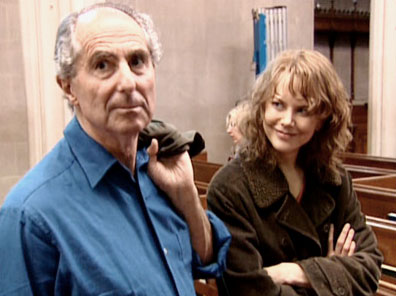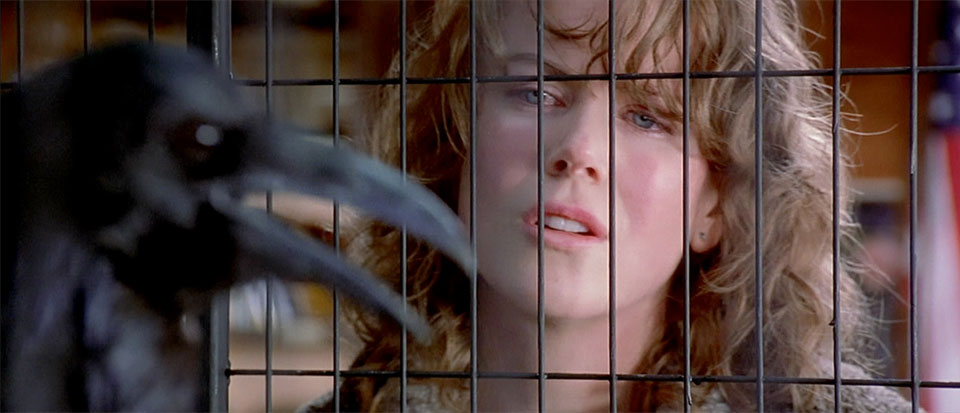Dir. by Robert Benton
I really like this image, which I grabbed from a brief making-of featurette available on the DVD release of The Human Stain. Philip Roth isn’t a participant, really, but he does show up in this one shot — the very last shot of the featurette. He’s turning his head from left to right, I assume because he’s just noticed that he’s being filmed, and there’s a charming look of amusement on his face.

He’s chatting with Nicole Kidman, and Anthony Hopkins is also there in the room. As is Gary Sinise, who’s pretending for the day to be Nathan Zuckerman, a successful Jewish writer now sequestered and hard at work in an isolated cabin somewhere in the wilds of Thoreau and Hawthorne country. Roth, of course, has been pretending to be Zuckerman for nearly thirty years now. Come to think of it, this image could have come directly from the pages of one of his novels — somewhere, maybe, between Deception and The Counterlife: “Philip Roth” meets “Nathan Zuckerman” and all epistemological hell breaks loose.
The Human Stain is a little more impressive each time I read it. I’m still frustrated by the sadistic delight with which Roth degrades and destroys Delphine Roux, the 100-pound beauty of a French feminist scholar who, as it turns out, really just needs a good fuck from a virile classical humanist like Coleman Silk. And Les Farley, the deranged Vietnam vet, is never developed too far beyond the deranged Vietnam vet “type”; though, to Roth’s credit, Les does come to life — and then some — in one or two of the best scenes Roth has ever written, most notably the conversation between him and Zuckerman that ends the novel. But those are minor complaints, really. Of Roth’s writing of the last twenty-five years, The Human Stain, I think, is second only to American Pastoral in terms of ambition, formal invention, and sheer imaginative force.
I have no idea if Robert Benton’s adaptation of The Human Stain works on its own as a film. (The Almighty Tomatometer gives it a 41%, so consensus seems to be that it doesn’t quite.) Like the Tolkein-o-philes who continue to parse through every last detail of the Rings trilogy, I read Benton’s film as a vast intertext consisting of Roth’s many novels, his critics, the interviews, the essays, and my own evolving thoughts about — not to mention my imaginings of — The Human Stain itself. What I did last night barely qualifies as “watching a movie.” In the guise of objectivity, though, I’ll say this much: Nicholas Meyer’s screenplay streamlines the various storylines to focus more intently on the relationship between Coleman Silk (Hopkins) and Faunia Farley (Kidman), which seems a perfectly logical choice. He and Benton cut between the postwar promise of 1948 and the politically correct era of fifty years later with a fluidity that gives cohesion to both halves of Silk. And I was especially impressed by Wentworth Miller and Jacinda Barrett, who play the young Silk and his first love, Steena “Voluptas” Paulsson. Their too-brief scenes together restore a sense of balance and scaled-down emotions to a film in more need of both.
Adaptation is always, in some sense, an act of criticism, I suppose. Meyer and Benton, in close collaboration with their actors and crew, have in essence performed a close reading of Roth’s novel. For example, Meyer has chosen to keep Zuckerman as a narrative device — the author/detective who reconstructs “the whole story” — and Benton foregrounds that device by shooting most of the film from an objective remove. With only a few notable exceptions (Faunia’s discussion with the crow, for instance) the film is almost completely devoid of eyeline matches. When Steena dances for Silk, the camera stays near the back of the room, never allowing us to align too closely our own perception of the film’s world with Silk’s. This is an essential characteristic of Roth’s recent work, nicely transposed to the film.
But the adaptation of a written text to film also necessarily foregrounds the authority of images, imposing specificity on what an author might have chosen to describe more generally. I was surprised, for example, to find myself suddenly moved by an image of the small boxes in which Faunia stores the ashes of her dead children. In the novel, surprisingly little emphasis is placed on the ashes; Roth does not make of them an excuse for one of his patented ten-page diversions. (I love Roth most of all for his ten-page diversions.) But seeing the boxes in the film — those specific boxes, small, gold, hidden below her bed frame — became an essential moment in the development of Faunia’s character, more essential, I would argue, than Kidman’s overwrought monologue that immediately follows. They are present, like a memento mori, with a force that Roth’s writing never achieves.
An even more interesting example is Coleman’s last professional fight. Roth’s description:
Walking down the aisle for the six-rounder, Coleman had had to pass the ringside seat of Solly Tabak, the promoter, who was always dangling a contract in front of Coleman to sign away a third of his earnings for the next ten years. Solly slapped him on the behind and, in his meaty whisper, told him, “Feel the nigger out in the first round, see what he’s got, Silky, and give the people their money’s worth.” Coleman nodded at Tabak and smiled but, while climbing into the ring, thought, Fuck You. I’m getting a hundred dollars, and I’m going to let some guy hit me to give the people their money’s worth? I’m supposed to give a shit about some jerkoff sitting in the fifteenth row? I’m a hundred and thirty-nine pounds and five foot eight and a half, he’s a hundred and forty-five and five foot ten, and I’m supposed to let the guy hit me in the head four, five, ten extra times in order to put on a show? Fuck the show.
After the fight Solly was not happy with Coleman’s behavior. It struck him as juvenile. “You could have stopped the nigger in the fourth round instead of the first and gave the people their money’s worth. But you didn’t. I ask you nicely, and you don’t do what I ask you. Why’s that, wise guy?”
“Because I don’t carry no nigger.” (116, 117)
On the page, that scene is about Coleman’s arrogance, his intellectual superiority. Boxing, he tells his parents earlier, is a matter of outsmarting one’s opponent. The film, however, foregrounds the significance of Roth’s elision: “After the fight . . .” Benton chooses, instead, to shoot the boxing match Rocky-style, and so we are forced to watch the light-skinned Coleman, passing as a Jew, “outsmarting” his black opponent by beating him senseless. Not surprisingly, the rhythm of Wentworth Miller’s performance feels forced and awkward when he delivers the line towards which Roth’s prose so carefully builds: “Because I don’t carry no nigger.” On film, the words have been overpowered and made redundant by the force of the visual image. (I’m embarrassed to admit that, until I saw Silk fight, I’d never seriously considered the importance of Invisible Man — and “The Battle Royal,” specifically — as a precedent for The Human Stain.)
